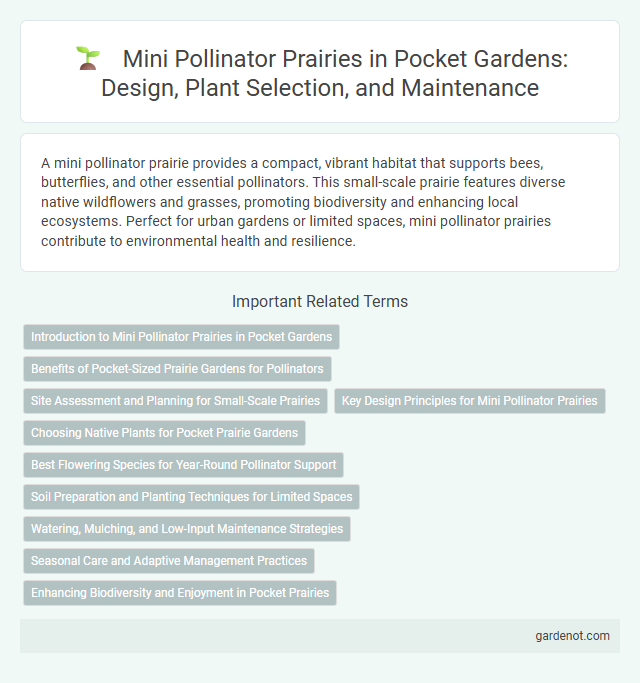A mini pollinator prairie provides a compact, vibrant habitat that supports bees, butterflies, and other essential pollinators. This small-scale prairie features diverse native wildflowers and grasses, promoting biodiversity and enhancing local ecosystems. Perfect for urban gardens or limited spaces, mini pollinator prairies contribute to environmental health and resilience.
Introduction to Mini Pollinator Prairies in Pocket Gardens
Mini pollinator prairies in pocket gardens create vibrant habitats that support essential pollinators like bees, butterflies, and hummingbirds, enhancing local biodiversity. These small-scale prairies feature native wildflowers and grasses specifically chosen for their ability to attract and nourish pollinators through nectar and pollen resources. Implementing mini pollinator prairies contributes to ecosystem resilience and promotes sustainable gardening practices in urban and suburban environments.
Benefits of Pocket-Sized Prairie Gardens for Pollinators
Mini pollinator prairies provide essential habitats for native bees, butterflies, and other pollinators by offering diverse nectar and pollen sources in compact urban or suburban environments. These pocket-sized prairie gardens enhance biodiversity, improve pollination rates for nearby crops, and support ecosystem resilience. Their strategic planting of native wildflowers and grasses creates continuous bloom cycles that sustain pollinator populations throughout the growing season.
Site Assessment and Planning for Small-Scale Prairies
Site assessment for mini pollinator prairies involves analyzing soil type, sun exposure, and existing vegetation to select optimal native plant species that support local pollinators. Planning prioritizes spatial constraints and microhabitat diversity to create resilient, biodiverse pockets that thrive in small urban or suburban environments. Careful consideration of water drainage and proximity to pollinator sources enhances habitat effectiveness and sustainability.
Key Design Principles for Mini Pollinator Prairies
Mini pollinator prairies thrive on key design principles such as diverse native plant selection, spatial arrangement to maximize sunlight exposure, and incorporation of layered vegetation structure for varied pollinator habitats. Optimal soil preparation and inclusion of flowering species with staggered bloom times extend forage availability, supporting a broad spectrum of pollinators throughout the growing season. Integrating native grasses and flowering forbs ensures ecological balance, enhances biodiversity, and increases resilience against pests and climatic fluctuations.
Choosing Native Plants for Pocket Prairie Gardens
Selecting native plants such as black-eyed Susan, purple coneflower, and milkweed enhances mini pollinator prairies by providing essential nectar and habitat for local bees, butterflies, and other pollinators. These species support biodiversity and are well-adapted to regional soil and climate conditions, reducing maintenance needs and promoting ecological balance. Integrating a diverse mix of native grasses and flowering plants strengthens pollinator networks and ensures year-round forage availability in pocket prairie gardens.
Best Flowering Species for Year-Round Pollinator Support
Mini pollinator prairies thrive with a diverse mix of flowering species such as Echinacea purpurea, Asclepias tuberosa, and Solidago canadensis, which ensure continuous nectar and pollen availability from spring through fall. These plants attract a wide range of pollinators including bumblebees, monarch butterflies, and native solitary bees, providing essential habitat and food resources. Selecting species with staggered bloom periods enhances year-round support for pollinator health and biodiversity in pocket prairie ecosystems.
Soil Preparation and Planting Techniques for Limited Spaces
Mini pollinator prairies thrive with well-prepared soil that is free of weeds and loosened to a depth of 6-8 inches, promoting strong root development for native wildflowers and grasses. Using hand tools or small garden equipment ensures soil disturbance is minimized in limited spaces, maintaining soil structure and moisture retention. Planting techniques such as precise seed broadcasting or spot seeding native pollinator-friendly species improve establishment success while maximizing space efficiency in pocket prairie gardens.
Watering, Mulching, and Low-Input Maintenance Strategies
Mini pollinator prairies thrive with targeted watering strategies, favoring deep, infrequent irrigation to establish strong root systems while conserving water resources. Applying organic mulch such as shredded leaves or straw reduces moisture evaporation, suppresses weeds, and enhances soil health. Low-input maintenance includes minimal mowing and avoiding synthetic fertilizers or pesticides, promoting native pollinator diversity and long-term ecosystem resilience.
Seasonal Care and Adaptive Management Practices
Mini pollinator prairies require seasonal care involving targeted watering during dry periods and selective mowing to promote native wildflower growth while suppressing invasive species. Adaptive management practices include monitoring pollinator activity and plant health to inform adjustments in plant species composition and maintenance schedules. These strategies optimize habitat quality, supporting diverse pollinator populations throughout changing seasonal conditions.
Enhancing Biodiversity and Enjoyment in Pocket Prairies
Mini pollinator prairies significantly boost biodiversity by providing essential habitats for native bees, butterflies, and other pollinators within pocket prairies. These small-scale ecosystems support diverse plant species that offer continuous blooms, ensuring pollinator food sources throughout the growing season. Integrating mini pollinator prairies enhances ecological resilience while creating visually appealing green spaces that promote environmental education and enjoyment.
Mini pollinator prairie Infographic

 gardenot.com
gardenot.com